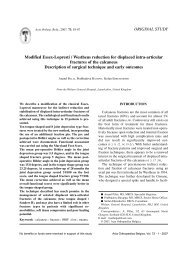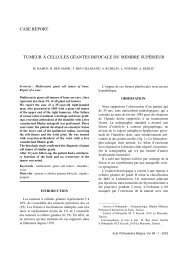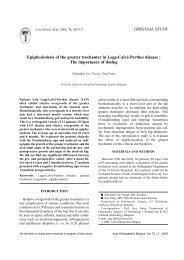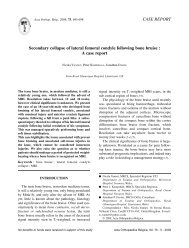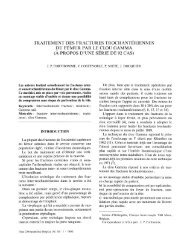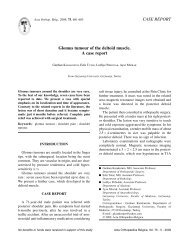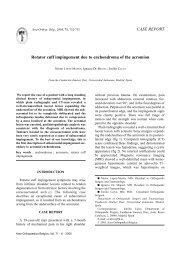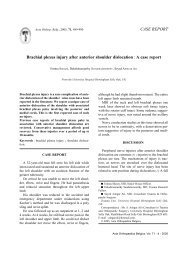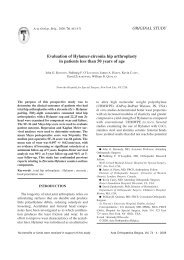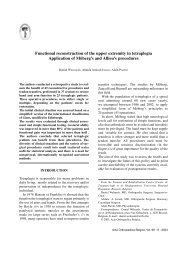ORIGINAL STUDY Acromioclavicular joint reconstruction using the ...
ORIGINAL STUDY Acromioclavicular joint reconstruction using the ...
ORIGINAL STUDY Acromioclavicular joint reconstruction using the ...
You also want an ePaper? Increase the reach of your titles
YUMPU automatically turns print PDFs into web optimized ePapers that Google loves.
170 R. BHATTACHARYA, L. GOODCHILD, A. RANGANTable I. — Postoperative scoresMean Standard RangedeviationPost-op Constant score 83.1 12 61-100Post-op Imatani score 81.2 19.4 51-98Post-op Walsh scores 14.1 4.3 8-20Constant score : 0 to 100. Normal is 100.Imatani score : 0 to 100. Normal is 100.Walsh score : 0 to 20. Normal is 20.Fig. 6. — Pre-operative and post-operative x-raysreasonably well in all three scoring systems(table II). There was a rupture of <strong>the</strong> central portionof <strong>the</strong> ligament in one patient after 6 months andthis had to be revised with a clavicular hook plate,hence this patient’s follow-up was considered onlytill 6 months. All <strong>the</strong> patients in <strong>the</strong> above studyhad been treated with <strong>the</strong> unmodified ligament butonly one had <strong>the</strong> ligament rupture. Followingdetailed analysis of this retrieved ligament, <strong>the</strong>pros<strong>the</strong>sis has since been reinforced and streng<strong>the</strong>nedin <strong>the</strong> central portion.DISCUSSIONSurgery for A-C <strong>joint</strong> separation has remained adebated issue over <strong>the</strong> years. When surgical treatmentis indicated, <strong>the</strong>re are a variety of operationsto choose from that have varying degrees of successreported in <strong>the</strong> literature (3).The Weaver-Dunn procedure, where <strong>the</strong> coracoacromialligament is detached from its acromialinsertion and reattached within <strong>the</strong> intramedullarycavity of <strong>the</strong> clavicle has gained considerable popularity.O<strong>the</strong>r methods of A-C <strong>joint</strong> fixation <strong>using</strong><strong>the</strong> coraco-acromial ligament have also been proposed(4,6,11,13,20,25). More recently, <strong>the</strong> importanceof preserving <strong>the</strong> subacromial arch andspecifically <strong>the</strong> coraco-acromial ligament has beenstressed (12,14). Biomechanical studies have shownthat release of <strong>the</strong> coraco-acromial ligament canlead to increased glenohumeral <strong>joint</strong> translationand laxity (14) while phylomorphic analyses havestressed <strong>the</strong> role of <strong>the</strong> coraco-acromial ligamentto provide increased mechanical stability of <strong>the</strong>shoulder (12). The coraco-acromial ligament alsoacts as a buffer between <strong>the</strong> acromion and <strong>the</strong>rotator cuff and this buffering action is lost incoraco-acromial ligament transection (19). Anadvantage of <strong>the</strong> Surgilig is <strong>the</strong> sparing of <strong>the</strong>coraco-acromial arch. Besides, occasionally, patientspresent with failed Weaver-Dunn procedures or arepeat A-C <strong>joint</strong> disruption after o<strong>the</strong>r types ofprevious stabilisation with <strong>the</strong> coraco-acromialligament. The Nottingham Surgilig would be auseful alternative to consider in <strong>the</strong>se situations.Our series is based mainly on <strong>the</strong> results of late<strong>reconstruction</strong>s of chronic Rockwood Type 3 A-C<strong>joint</strong> disruption. Although <strong>the</strong> literature describesvarious forms of surgery in A-C <strong>joint</strong> disruption,very few papers deal with <strong>the</strong> results of surgery insymptomatic chronic injuries having late <strong>reconstruction</strong>(3,4,6,15,25) and even fewer look exclusivelyat grade 3 injuries (25). Most of <strong>the</strong> papers reporta mixed population of injuries. While some of <strong>the</strong>sehave a very few chronic cases (24), some fail toreport <strong>the</strong> results of <strong>the</strong> chronic group separately(9). Besides <strong>the</strong> lack of homogeneity in <strong>the</strong> studyActa Orthopædica Belgica, Vol. 74 - 2 - 2008



